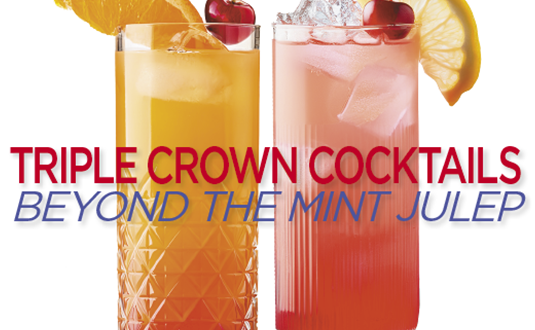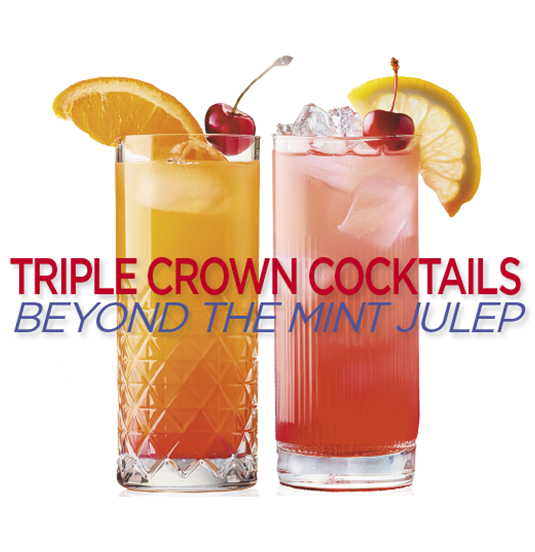TRIPLE CROWN COCKTAILS-BEYOND THE MINT JULEP
TRIPLE CROWN COCKTAILS
The Kentucky Derby is the most famous, and most well attended, of all the annual Triple Crown of Thoroughbred Races, legendary for the volume of Mint Juleps consumed there, about 120,000. But the Preakness Stakes and the Belmont Stakes offer an opportunity to reprise your sporty drinking twice more this year, each with their own cocktail and aesthetic.
May 3, 2025 will mark the 151st running of the Kentucky Derby, often dubbed “the most exciting 2 minutes in sports.” For cocktail lovers, the Derby is an exciting day because it’s an excuse to bust out our fancy tins and show off Julep-making skills. Everyone will be talking about the Mint Julep this month, and I will most certainly be mixing these and their variations on May 3rd. But there’s more to horse racing spectatorship than Mint Juleps.
COCKTAILS AND HORSE RACING
Horse racing and cocktails have always been intertwined, and many believe that the term “cocktail” takes its name from horse racing terminology. Indeed, “cock-tail” has historically referred to the lively appearance of a horse’s tail, either because it was docked, or for other, um, manipulated reasons. Horse breeders were known to go to great (and creative) lengths to make tails “perky” during inspections prior to a sale. However the term came to be, sporty men in 19th century America were knocking back plenty of cocktails. In his foundational history of pre-Prohibition drinking Imbibe, David Wondrich describes these men, part of the “sporting fraternity” of that era, as “the loose association of individuals whose avocation was the life of sports and games.” No, they weren’t playing the sports, they were watching them from a safe distance, “[limiting] participation to the realm of speculative finance.”
The Sporting Fraternity doesn’t describe a singular formal club, or even a social strata, but more a type of guy with a certain vibe. As Wondrich explains, sporting men “hung around in saloons and gambling halls, avoiding their civic duty to act all responsible and work long, sobering hours for peanuts to increase the profits of other men. If they had hearths to go home to, you wouldn’t know it. If they belonged to a church, you wouldn’t know that, either.” They were the antithesis of Victorian ideals, which espoused thrift, personal responsibility, morality, family, duty, and virtue. In a sense, sporting men of the Gilded Age were that era’s lifestyle influencers: “as for money, when they had it they had it and when they didn’t you wouldn’t know by looking at them,” writes Wondrich. Maintaining a good ‘front’ was key: “a true sport would spend his last fifty cents on a cognac Cocktail and having his coat brushed, with a ten-cent tip for the boy who brushed it. You were rich, you were broke, you were rich again – sometimes all on the same day. For the Victorians, money was an object, for the Sport it was a process.”
Honestly, the Sports seem like a great time!
RUN FOR THE BLACK EYED SUSANS
The Preakness Stakes is the second in the Triple Crown series, and is held every third Saturday in May, two weeks after the Kentucky Derby, at the Pimlico Race Course in Baltimore, Maryland. This year, the Preakness will take place on May 17th. Whereas the Kentucky Derby is the “run for the roses”, the signature flower of the Preakness is the Black-Eyed Susan. This beautiful yellow bloom was selected because it is the state flower of Maryland, however these beauties don’t actually bloom until June or July. The Preakness folks found a workaround, of course – historically painting yellow daisies and mums black in the center and, more recently, featuring Viking Poms. The winner of the race is presented with a blanket of these.
The Black Eyed Susan is also the name of the official race day cocktail, though the origins of the drink are a bit more obscure. Many sources credit Harry M. Stevens, who was a successful concessionaire that supplied many ballparks and racetracks with refreshments starting in the early 1900s and is also credited with inventing the hot dog. The Black Eyed Susan was invented in 1973, thirty-nine years after Mr. Stevens had passed away, however his company still ran catering for the track, so most likely some bartender or marketer dreamed this up. Some sources credit the drink to the famous Heublein company who created the cocktail as a ready-to-drink offering to be served en masse. But that’s not a good story, so they promoted it with whimsical marketing copy: “Black Eyed Susan – the drink that was born at Pimlico. Said to be an invention of a daring horse-owning notable in the early days of the Maryland Jockey Club, the Black Eyed Susan, official drink of the famed Preakness Stakes, is a tradition at Pimlico. It’s a bold and racy kind of drink with a clean start and an unflagging finish. As exhilarating as a golden day at the track.“
As the story goes, when Heublein refused to divulge the recipe, the caterers at Pimlico reverse engineered it. Ever since, the recipe has changed to reflect the featured alcohol sponsors in a given year, which accounts for the myriad different recipes floating around the internet for this libation. Below is a particularly tasty version:
TEST OF THE CHAMPIONS
The final race in the Triple Crown series is the Belmont Stakes, run at Belmont Park in Elmont, New York, Long Island. This race is held three weeks after the Preakness and five weeks after the Derby. The signature blooms for this event are white carnations. As the final race in the trio, this Run for Carnations is also dubbed the Test of Champions. The Belmont Stakes has had a variety of different signature cocktails over the years. The Belmont Park is the oldest recipe, dating to the 1920s, made with Bacardi rum, port, one egg and a teaspoonful of powdered sugar. In 1976 the Big Apple, made with fruit juice, apple liqueur and rum, had a brief run, before being supplanted by The White Carnation, made with vodka, peach schnapps, orange juice, soda water, and cream. This creamsicle-esque drink is very of the era, but by the ‘90s cream drinks were definitely out and needed a refresh.
In 1997 famous New York bartender Dale DeGroff, “King Cocktail”, was enlisted to create a new signature drink for the Belmont Stakes, and created the Belmont Breeze, made with bourbon, sherry, lemon juice, orange juice, pomegranate juice, simple syrup and mint. The Belmont Jewel, made with bourbon, lemonade and pomegranate juice, replaced DeGroff’s concoction in 2011. Belmont Stakes signature cocktail list through the years could be a cocktail party menu of its own!
By sipping a cocktail in your finery as you cheer on the ponies, take heart in knowing that you’re participating in a time-honored tradition, especially if it includes a little friendly wager on who will win. As you don your Derby day hat and seersucker suit, pour one out for the Sports!
FOR THE SOUR MIX
1 cup water
1 cup sugar
1 cup fresh lemon juice
3/4 cup fresh lime juice
To make sour mix, bring water and sugar to a simmer over medium heat in a small saucepan, stirring, until sugar dissolves. Remove from heat, cool,
and stir in lemon juice and
lime juice. Put in a jar,
cover, and refrigerate.
BLACK EYED SUSAN
2 ounces of sour mix (make it fresh)
1 ounce of bourbon (or rum!)
1 ounce of vodka
1 ounce of peach schnapps
2 ounces of fresh orange juice
1/2 orange slice, for garnish
1 cherry, for garnish
Shake ingredients in a cocktail shaker with ice. Strain over crushed or cracked ice into a tall glass. Garnish with an orange slice and cherry.
THE BELMONT JEWEL
1 1/2 ounces of Bourbon
2 ounces of lemonade
1 ounce of pomegranate juice
Lemon wedge or cherry for garnish
Shake ingredients in a cocktail shaker with ice.
Strain over new ice into a double old-fashioned glass. Garnish with a lemon wedge or cherry.


